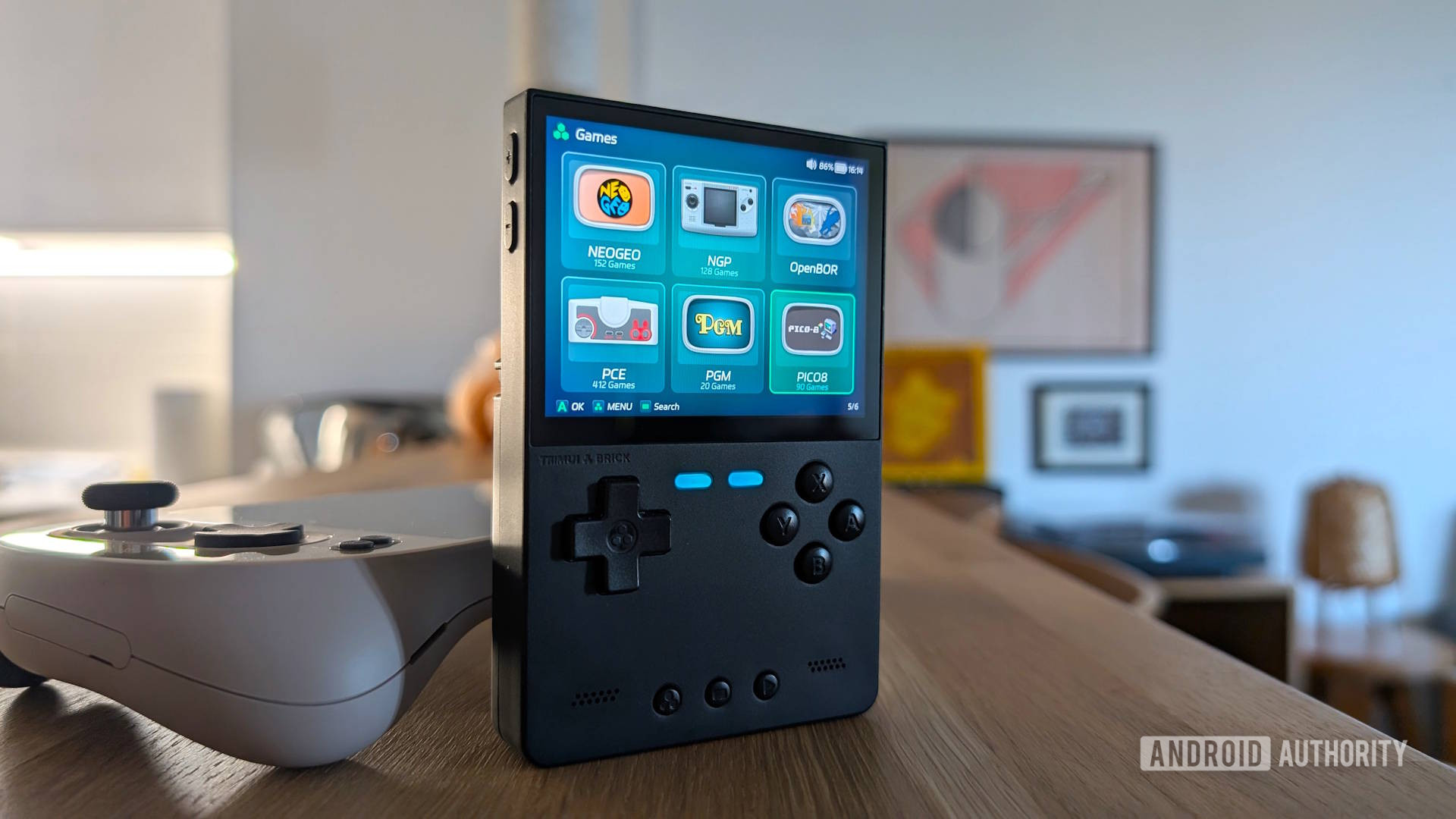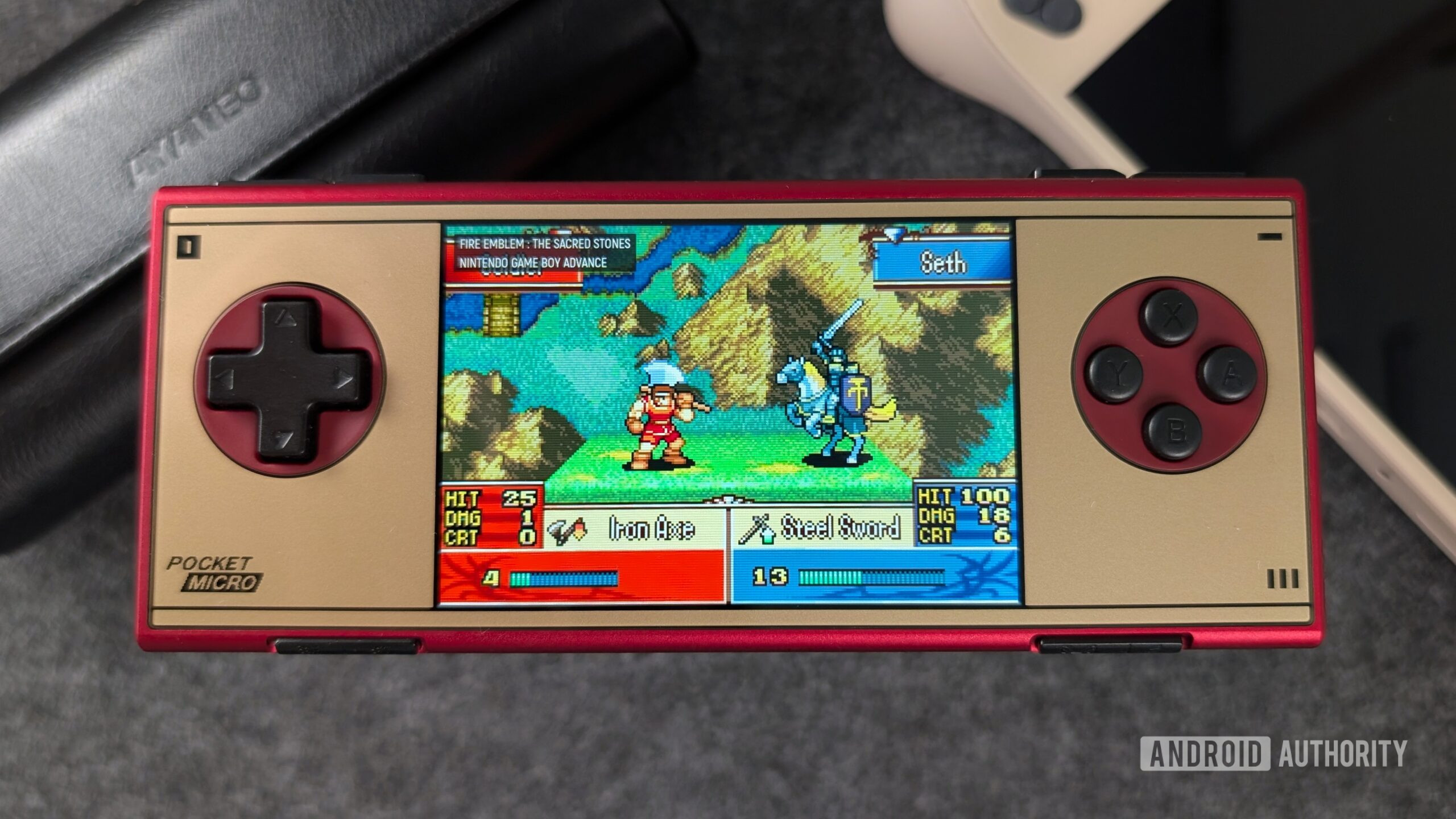
Nick Fernandez / Android Authority
Retro gaming handhelds Has come a long way in recent years, but there is still one big point of view: the layout. Every time a new handheld comes in for review, I have to spend hours installing emulators, fixing folder structures and configuring a front end.
When done, I still need to configure settings and shade for each console separately, which requires Arcane knowledge in popular emulators such as Retroarch.
Compared to Linux-based handheld, it’s a terrible experience. My Trimui smart pro Come ready to play out of the box: Emulators, controls and outlined room files included. To have an even better experience, I just appeared the SD card and loaded Crossmixos, which has all pre-configured (including shadowing).
At this time I have become quite good at running through the emulator Gauntlet for each new handheld. It is the long, reimbursable cut scene before the game actually starts. Some firmware fetishists like the process even more than the play itself, but I can’t help but think it’s a better way.
With great power comes great headache

Nick Fernandez / Android Authority
To be clear, Android Gaming -Handheld is generally better and more powerful than the Linux colleagues. I have not yet found a Linux handheld that can reliably handle PS2 emulation, with most of the Dreamcast and PSP detection.
And yes, I know Steam deck is technically a Linux handheld, but I want to put it in a separate category. Although I would say that almost all my complaints about Android also apply to the most important Steamos competitor, Windows.
But getting back to the point, Android Gaming -handheld is more powerful because they are tied to Android. When Qualcomm and other develop new pieces, they naturally take care of playing handheld after a few years. We even get chipset designed specifically for game handheld in Snapdragon G-Series Chips.
Handheld Android games are more powerful than its Linux-based peers.
While the chipsets have jumped forward, the software is still stuck in the telephone country. The multi -headed Behemoth that is Android has barely found out tablets, so it is not surprising that the handheld gaming experience has not developed to fit the form factor.
And it’s really rubbing: setting up an Android game handheld is the same process as setting up a phone. You will probably only do this once a few years for your smartphone, but if you are as dependent on the game handed as I am, you will repeat this page assignment by a few months.
To make it worse, many emulators are not available in the Google Play Store. You need to side them from different websites and Github sites, all while avoiding Dodgy websites trying to fill your device with malicious software.
Not quite clear, plays one

Nick Fernandez / Android Authority
I will call out some companies that make some efforts to make the process smoother. The first is Retroid, which gives you a simple list of emulators to install during the installation process. You just need to check the boxes and the device does the rest.
The problem is that the list is outdated. It recommends a few emulators that are no longer in active development, and excludes any of Best emulators on android. This is confusing at best for new users, and in the worst case, it can have a serious impact on how good games are going. It’s a great effort, but in the end I ignored it and installed everything manually.
Android devices from Anbernic are often supplied with emulators installed, but the list can be hit or missed. For example, it may have aethersx2 instead of the newer Nethersx2. It can use drastically, a DS emulator that has not been updated in many years, instead of Melonds, which is now generally a better choice. I could start games out of the box, but they always demanded some extra fine adjustment.
Other handheld manufacturers, such as the lesser-known Kinhank, ship units with the Android installation process complete and a few pre-installed emulators. The recently released Kinhank K56, for example, solves many of the problems I listed above, and it is probably the closest you can get to a plug-and-play Android-Handheld.
It has retroark and a few other emulators installed and (mostly) configured. It also has two fronts, including my personal favorite, Es-of. The problem is that the hardware itself is not very good. There is budget through and through, and not a unit I would recommend. There are many Linux devices that offer the same thing or more for less money.
Most good Android -handheld ships with little or no emulation software installed or configured.
The sad truth is that the best Android handling does not include anything. Ayn Odin 2 portal and top-specific Ayaneo devices that pocket Evo, Dmgand ACE Has nothing pre -installed besides performance tools and maybe a medium front end. The rest is up to you.
Anbernic is another interesting matter, since it makes both Linux and Android handheld. The Linux devices are mostly configured, but Android devices are much more just bone. There is a controversial (and Probably illegally) Pre-installed app to download rooms, but nothing to install or configure emulators.
It’s time to smooth up

Nick Fernandez / Android Authority
After going through the setup process countless times now, I understand why it is difficult for OEM to solve this problem. Things like Legacy Android jank, fragmented emulator development and potential legal pitfalls of emulation are beyond their control, but I have a few suggestions.
I do not expect OEMs to pre-install and configure each emulator (even if they do on the Linux-handheld), but if they just configured one, it will save lots of time during the setup. And that emulator is retroarch.
Retroarch is the all-end-all emulator for most platforms, with cores for just about all systems under the sun. Usually you need to install it (from the site, not the play store), download the cores, set up controls and quick keys, find your room and BIOS folders, fine -tune settings for your screen and more before jumping into a game.
The list of things retroark can do is almost endless, which is a big part of the problem. Everything is hidden behind levels of menus that require full review to set up.
Also, retroarch is extremely stable. Updates are few and far between, and they mostly adjust small settings or add new cores. There is no reason why a completely configured retroarch will not work as well in three years as it does today. If each Android-based handheld had retroarch pre-installed and configured, they would almost be plug-and-play. Kinhank is the only company found out.
Pre-configured retroarch settings will make devices almost plug-and play.
It’s a star here, and it’s BIOS. Most older systems do not need BIOS to play, but some emulators will require you to rip and upload BIOS from your own system. Like rooms -you can download them online, and some sketched handheld manufacturers will include them, but it is a legitimate minefield that most legitimate OEMs avoid.
For the emulators other than retroarch, a simple guide would go a long way. There are many community guides to help, but none of them have been embraced by OEMs. Even Retroid’s setup wizard feels like it has not been updated in many years, while emulation development for recent consoles has moved on at a burning pace.
A new game+ for Android -Handheld

Oliver Cragg / Android Authority
Ultimately, it is still quite early in the game for this type of emulation -focused handheld. Sure, they have been around for a long time, but the industry really gained momentum for the last four or five years. It is now handheld that fits any budget, size or design preference, which will make ten years old me shocked that I complain at all.
But with all advances in chipset, design and even embellishments, it is the past time we entered a new era of Android-based handheld. A new game+, if you want.
Most players pick up a handheld to play, do not set up emulators.
This time, the gate should not be part of the gameplay. We have the power, tools and user demand, but we lack a little more care to create the experience. The next generation devices could not only launch with better specifications, but with better standard values: thoughtful software, plug-and-play emulators and intuitive front ends that make setup optional, not important.
Because at the end of the day, most players did not pick up a handheld to configure side relationships or fix file structures – they just wanted to play.


